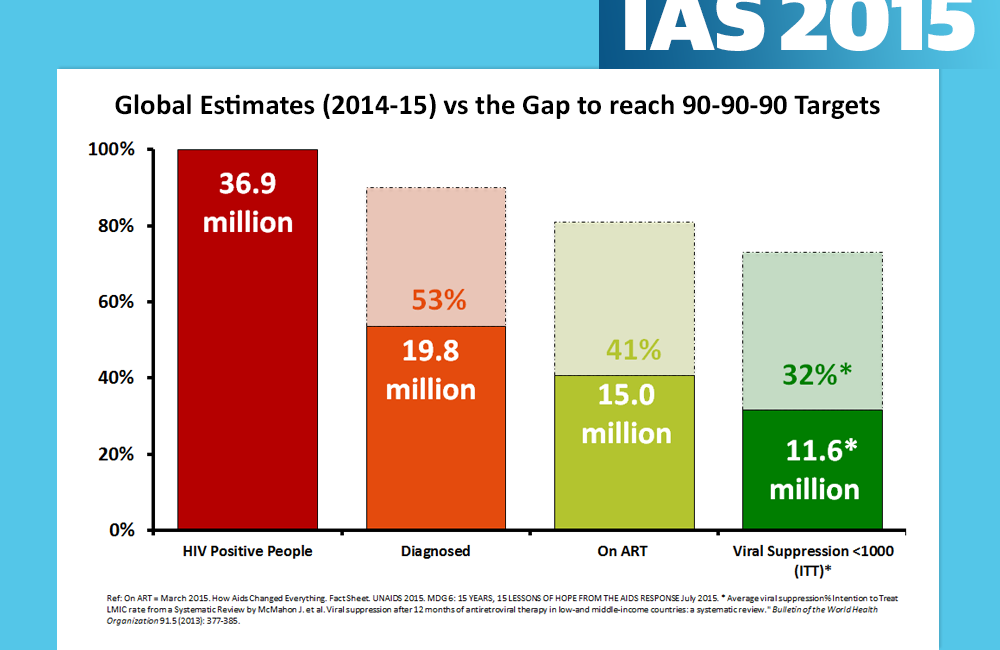
Global analysis of HIV treatment cascades – the proportions of people diagnosed with HIV, in care, on treatment and virally suppressed – shows that some of the world’s richest countries are still far short of achieving the UNAIDS 90-90-90 target, research from Imperial College London and Chelsea and Westminster Hospital shows. Progress is worst in Eastern Europe, where most countries lag behind average performance in sub-Saharan Africa on every indicator.
The findings were presented by Jacob Levi on Monday at the Eighth International AIDS Society Conference on HIV Pathogenesis, Treatment and Prevention (IAS 2015) in Vancouver, Canada – described by numerous speakers this week as the '90-90-90' conference.
The 90-90-90 target set by UNAIDS aims to diagnose 90% of all people with HIV, provide antiretroviral therapy for 90% of those diagnosed and achieve undetectable HIV RNA for 90% of those on treatment, by 2020. This ambitious target translates into undetectable viral load in 73% of all people living with HIV.
How far are countries from achieving these targets? In some cases fairly close, but in others, the gap is enormous.
Research conducted by a team from Imperial College and St Stephen's AIDS Trust, Chelsea and Westminster Hospital, London, and the Cantonal Hospital of St. Gallen, Switzerland, updating a previous survey presented at the 2014 Congress on Drug Therapy in HIV Infection in Glasgow, shows that Switzerland, Australia and the United Kingdom have the highest proportion of people living with HIV with undetectable viral load. In each of these countries, over 60% of the estimated population of people living with HIV have undetectable viral load, compared with 30% in the United States.
Worldwide, 36.9 million people are estimated to be living with HIV of whom 53% are diagnosed, 13.4 million people short of the 90% target, the researchers calculated, drawing on recent data from UNAIDS. Forty-one per cent are on treatment, 14.9 million people short of the target, and 32% are virally suppressed, 15.3 million people short of the target. Approximately 2 million people each year are becoming infected at current rates of transmission.
Breaking this down to look at national treatment cascades from 11 countries with full treatment cascade data and 9 countries with partial data (where data for some steps in the cascade may be missing, or total numbers of people are not reported), the research group found enormous variations at each stage of the treatment cascade. They sought to identify 'breakpoints' in the cascade – steps where more than 10% of people were lost.
The proportion of the estimated population of people living with HIV who had been diagnosed varied from 86% in the United States and Australia to 71% in Canada, 51% in sub-Saharan Africa, 45% in Colombia and 44% in Ukraine. Many countries were identified as having breakpoints in HIV diagnosis, indicating the global importance of improving rates of HIV diagnosis.
Retention and linkage to care are difficult to compare due to lack of data in some countries and a lack of a common definitions of linkage and retention in care.
Estimates of the proportion of people receiving antiretroviral therapy were calculated from government drug purchases and pharmacy records, and showed that treatment is a particular vulnerability in the treatment cascade for Australia, Denmark, Brazil, and most prominently, the United States, where just 37% of people are estimated to be on treatment, despite one of the highest rates of HIV diagnosis in the world. Treatment rates are abysmal in Eastern Europe, where just 29% of people are on treatment in Estonia despite a diagnosis rate of close to 90%, and just 11% of people are receiving treatment in Russia.
UNAIDS aims to move countries towards achieving viral suppression in 73% of all people living with HIV by 2020. Switzerland, Australia, the United Kingdom, Denmark and the Netherlands are well on their way to achieving this target; in each case, easily attainable improvements in the rate of diagnosis or treatment initiation should allow these countries to reach the goal.
Other countries that perform well in some areas are still lagging far behind when it comes to viral suppression. France reports that only 52% of people living with HIV are virally suppressed (compared to 61% in the United Kingdom and 52% in Rwanda), while 35% in British Columbia, Canada, 32% in sub-Saharan Africa and 30% in the United States are virally suppressed. Once again, rates of viral suppression are extremely low in Eastern Europe.
Monitoring and comparison of treatment cascades will be an important tool for benchmarking national and regional performance, and for accountability, speakers at the conference agreed.
Levi J et al. Can the UNAIDS 90-90-90 target be achieved? Analysis of 12 national level HIV treatment cascades.Eighth International AIDS Society Conference on HIV Pathogenesis, Treatment and Prevention, Vancouver, abstract MOAD0102, 2015.
A webcast of this presentation is available on the conference YouTube channel.
You can download the slides of this presentation from the conference website.
Where available, you can view details of sessions, view abstracts, download presentation slides and find webcasts using the conference 'Programme at a Glance' tool.
You can also download a PDF of the abstract book from the conference website.
